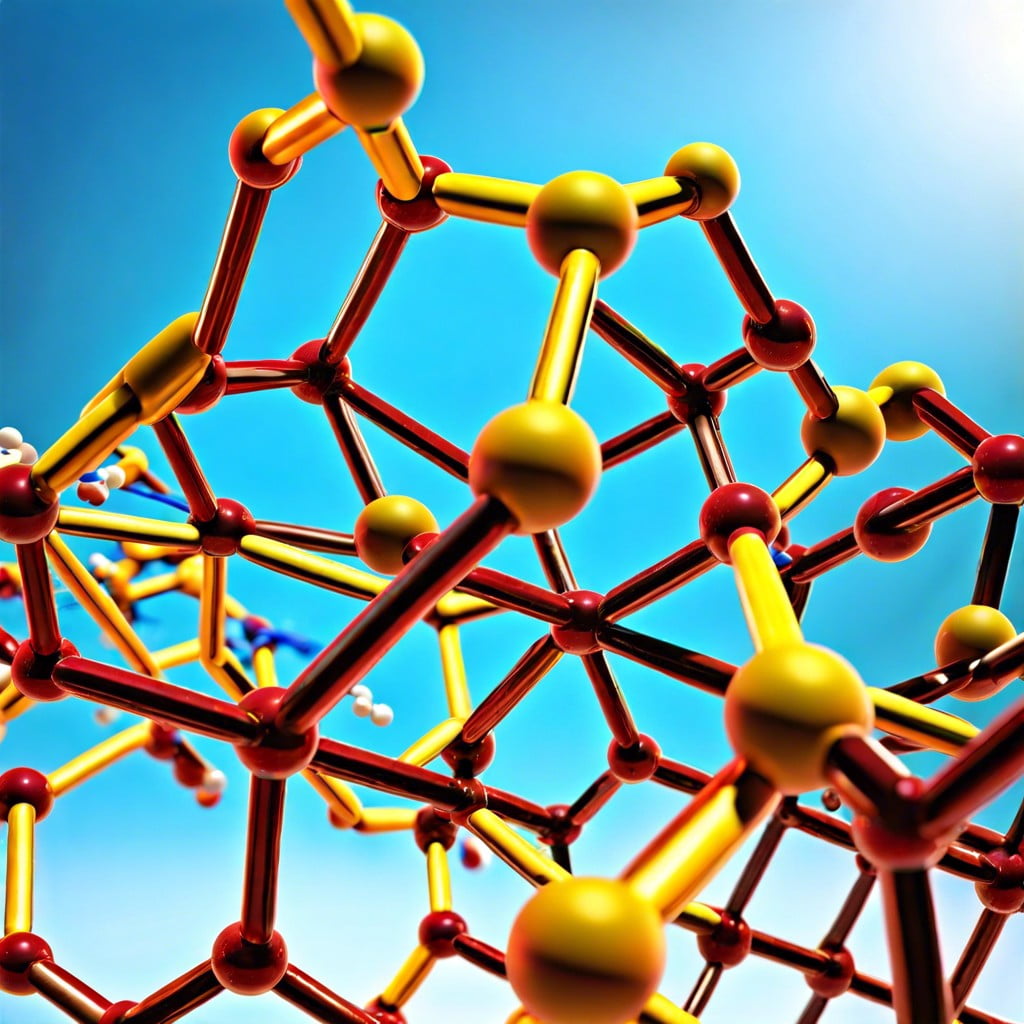This article will clarify whether DNA is a polymer by breaking down the scientific concept into digestible information.
Key takeaways:
- DNA is a polymer made up of repeating nucleotides.
- DNA’s double-helical structure is crucial for its function.
- DNA replication showcases the properties of a polymer in action.
- DNA’s polymeric nature enables advancements in biotechnology.
- Applications of DNA as a polymer include genetic engineering and DNA sequencing.
What Is a Polymer?

Polymers are large molecules made up of repeating structural units, typically connected by covalent chemical bonds. Imagine them like trains, where the cars are the smaller, repeating units known as monomers, linked together to form long chains. These chains can vary greatly in length, structure, and chemical composition, resulting in a diverse array of materials with distinct properties.
These substances are divided into two broad categories: synthetics like plastics and nylons, made by humans for various uses; and naturals like cellulose and proteins, formed by living organisms. Their versatility comes from the way monomers can be arranged to tailor the properties of the polymer. For instance, certain configurations make a polymer flexible, while others make it rigid. The variety of available monomers and ways they can be combined means polymers play essential roles in a vast range of applications from clothing and construction to medicine and electronics.
DNA As a Polymer
DNA, short for deoxyribonucleic acid, qualifies as a polymer because it consists of long chains of repeating units called nucleotides.
Each nucleotide comprises a phosphate group, a sugar molecule (deoxyribose), and a nitrogenous base (adenine, thymine, cytosine, or guanine).
These chains, known as polynucleotides, are similar to the beads on a string, where each “bead” is a nucleotide, and they’re connected to form a long, stable backbone for the overall structure of DNA.
In terms of its polymer characteristics, DNA is akin to other synthetic polymers, like nylon or polyethylene, in its repetitive structure.
However, DNA’s function and complexity are far more sophisticated due to its unique role in encoding genetic information.
Its double-helical structure—two polynucleotide strands wound around each other—is a result of complementary base pairing, with adenine pairing with thymine, and cytosine with guanine.
This polymeric pattern is crucial for DNA’s ability to replicate and transfer genetic information.
During cell division, enzymes ‘unzip’ the double helix, using each strand as a template to assemble a new complementary strand.
This is much like a precise copy machine, ensuring each cell inherits the same sequence of nucleotides as its predecessor.
The understanding of DNA as a polymer paves the way for innovations in genetic engineering and biotechnology.
Scientists harness this knowledge to manipulate DNA sequences, which contributes to advancements in fields such as medicine, agriculture, and forensics.
Chemical Structure of DNA
DNA, or deoxyribonucleic acid, is composed of long chains of repeating units called nucleotides. Each nucleotide is made up of three parts: a phosphate group, a sugar molecule (deoxyribose), and a nitrogenous base. There are four types of bases in DNA: adenine (A), thymine (T), cytosine (C), and guanine (G).
The sugar and phosphate form the backbone of the DNA polymer, with the bases attached to the sugar molecules like rungs on a ladder.
The structure of DNA is famously known as a double helix, which resembles a twisted ladder or spiral staircase. The bases pair up in a specific way: adenine with thymine, and cytosine with guanine, connected via hydrogen bonds. This base pairing is crucial as it allows DNA to hold the genetic blueprint in a very organized manner. The sequence of these bases along the DNA strand encodes the genetic information necessary for the formation and functioning of an organism.
The double-stranded nature of DNA is also integral to its stability and replication. During cell division, the two strands unzip, and each serves as a template for creating a new complementary strand, ensuring that the genetic information is faithfully passed on to the next generation. The resilience and specificity of DNA’s chemical structure highlight its sophisticated design as a polymer, tailormade for storing and transmitting life’s instructions.
DNA Replication and Its Relation to Polymer Structure
DNA replication showcases the inherent properties of a polymer in action. The process relies on the DNA molecule’s ability to duplicate itself precisely, which is possible due to its repetitive, chain-like structure.
- Complementary base pairing: Just as bricks connect based on their fit, nucleotide bases pair with complements along the polymer backbone, guiding the formation of a new strand.
- Enzyme action: Specialized proteins, called enzymes, read the DNA sequence and assemble a matching strand. This is akin to machines on a production line constructing a product by following a template.
- Strand elongation: As each new nucleotide is added, the DNA polymer grows, ensuring the genetic code is carried forward correctly.
This elegant process is an essential function of DNA polymer properties, ensuring life can replicate and thrive.
Applications of DNA’s Polymeric Nature in Biotechnology
DNA’s unique polymeric properties have significantly advanced biotechnology, enabling groundbreaking applications that impact various fields. Here are some of the ways in which the polymer nature of DNA is utilized:
- Genetic Engineering: The ability to replicate and modify the polymeric DNA strands leads to customized genes, enabling the development of genetically modified organisms (GMOs) for agriculture, medicine, and industry.
- Polymerase Chain Reaction (PCR): This technique amplifies specific DNA sequences. By understanding the polymer makeup of DNA, biotechnologists can replicate targeted sequences en masse for research, diagnostics, and forensics.
- DNA Sequencing: Deciphering the order of nucleotides in a DNA polymer has revolutionized our understanding of genetics, allowing for advancements in personalized medicine and ancestry testing.
- DNA Computing: Leveraging its ability to store and transmit information, DNA provides a medium for computational operations at a molecular level, offering potential for highly efficient data processing.
- Nanotechnology: DNA polymers can be used to create nanoscale structures and devices, owing to their predictable interaction patterns, and have applications in drug delivery and biosensor design.
These applications demonstrate the vast potential of DNA as a polymer within biotechnology, underpinning innovations that continue to transform science and technology.
FAQ
Why is DNA not A polymer?
Contrary to common misunderstanding, DNA is indeed a polymer, specifically a nucleic acid polymer composed of nucleotide monomers, each containing a deoxyribose sugar, a nitrogenous base, and a phosphoric acid group.
What material is DNA?
DNA is a material made of chemical building blocks called nucleotides, which consist of a phosphate group, a sugar group, and one of four types of nitrogen bases.
Is nucleotide A polymer?
No, a nucleotide is not a polymer; instead, it is a monomer that forms polymers like DNA or RNA.
Is DNA an addition polymer?
No, DNA is not an addition polymer as it’s a biological polymer, which is distinct due to its base pairs connected by hydrogen bonds rather than containing C=C bonds.
How do the structural features of DNA resemble those of a polymer?
The structural features of DNA resemble those of a polymer because they both have repeating units; in DNA, these are nucleotides while in polymers, these are monomers.
In what ways do polymers and nucleotides interact in the structure of DNA?
Polymers of nucleotides, namely deoxyribose, phosphate, and one of four bases, form the structurally stable double helix of DNA through complimentary base-pairing and hydrogen bonding interactions.
Can DNA be synthesized following the same process as a typical synthetic polymer?
No, DNA cannot be synthesized following the same process as a typical synthetic polymer due to its highly specific and complex biochemical process of formation.
Recap




